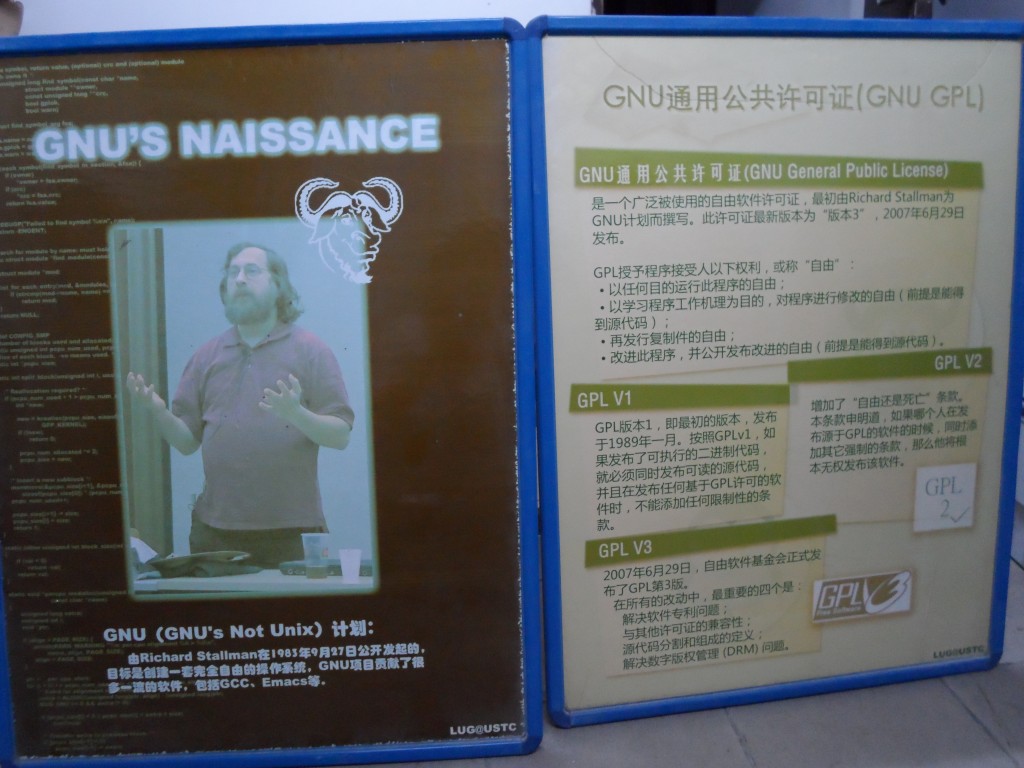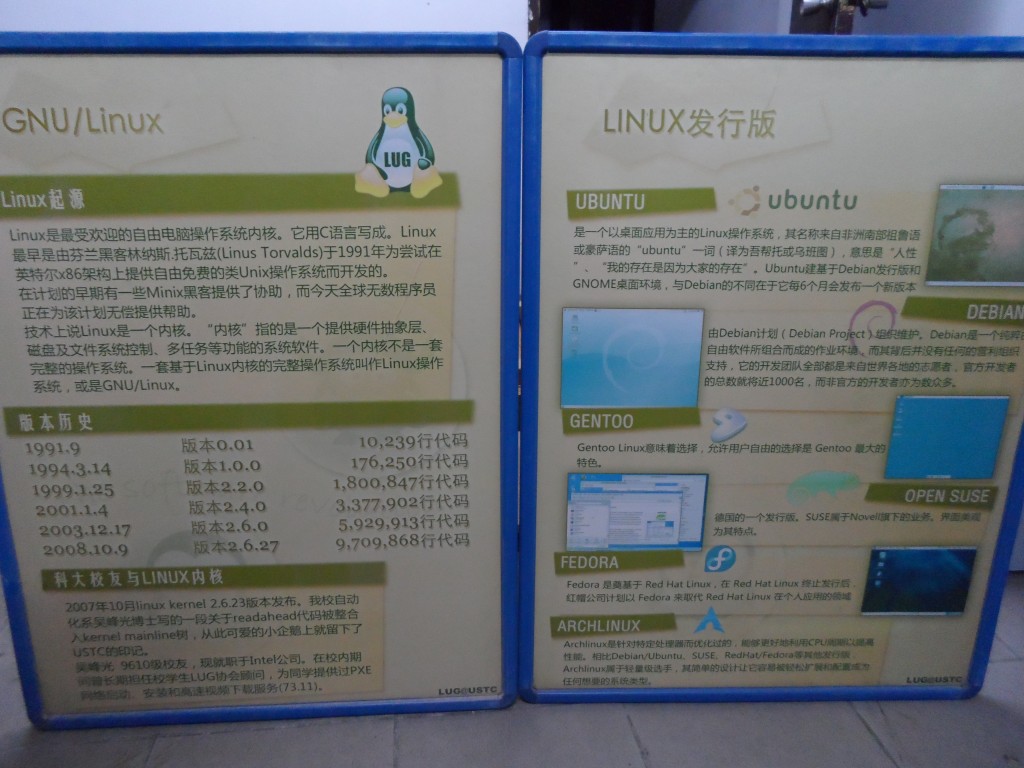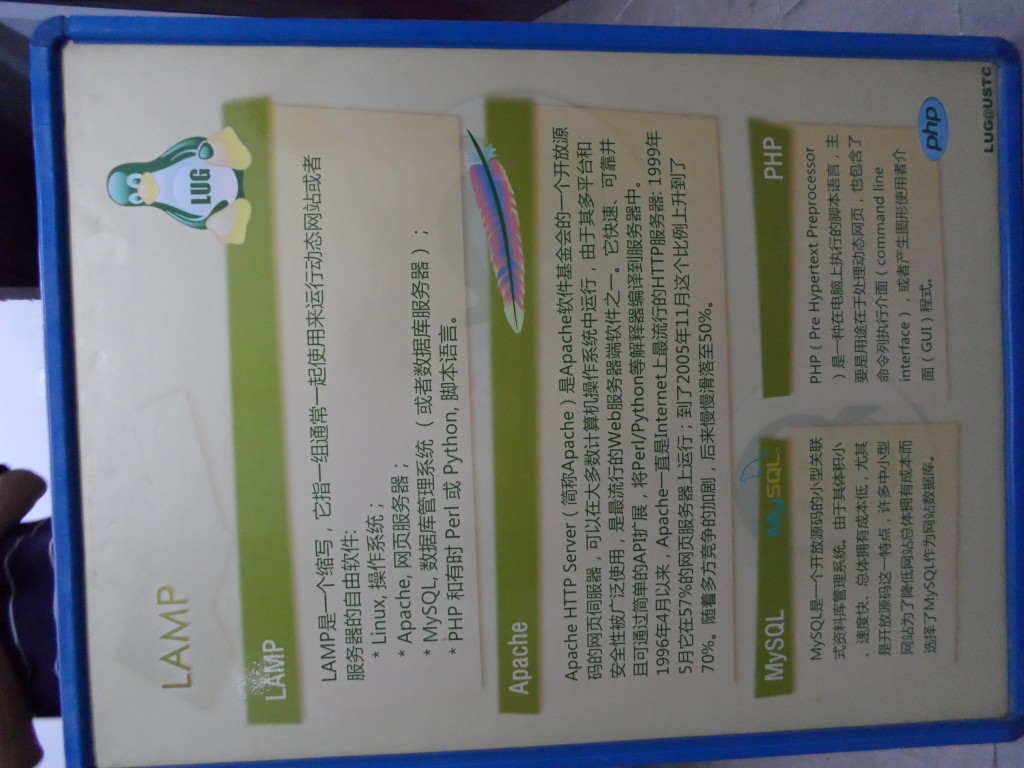Draft of LUG Display Board Text
GNU (GNU’s Not Unix) Project
Launched publicly by Richard Stallman on September 27, 1983, the goal is to create a completely free operating system. The GNU project has contributed many top-notch software, including GCC, Emacs, etc.
GNU General Public License (GNU GPL)
The GNU General Public License is a widely adopted free software license, initially written by Richard Stallman for the GNU project.
The GPL grants the following rights, or “freedoms”, to the program recipient:
- The freedom to run the program for any purpose
- The freedom to study the principles of software and modify the software to suit the user’s own needs (provided that the source code can be obtained)
- The freedom to distribute copies of the software
- The freedom to improve the software and publicly release improvements (provided that the source code can be obtained)
Compared with more permissive free software licenses such as BSD, the main difference of GPL is that it seeks to ensure that the above freedoms are guaranteed in copies and derivative works.
GPLv1 was released in January 1989. If executable binary code is released, readable source code must be released at the same time, and no restrictive terms can be added.
GPLv2 added the “freedom or death” clause: if other mandatory terms are attached when releasing software derived from GPL, then he will have no right to release the software at all.
GPLv3 was released in June 2007, the most important changes are:
- Solve software patent issues
- Compatibility with other licenses
- Definition of source code splitting and composition
- Digital Rights Management (DRM) issues
- Boot signature issues, such as UEFI
Linux
Origin of Linux
Linux is a free operating system kernel born, grown, and matured on the Internet. Linux was first developed by Finnish university student Linus Torvalds in 1991, his original intention was to provide a free and open-source Unix-like operating system on the x86 architecture.
Development of Linux
【Can use the Linux Foundation’s 20th anniversary of Linux image】
USTC Alumni and the Linux Kernel
In October 2007, Linux 2.6.23 was released. A piece of code about pre-reading written by Dr. Wu Fengguang of our school’s automation department was integrated into the kernel mainline, leaving the mark of USTC on the lovely penguin.
Wu Fengguang, a 9610 alumnus, is currently working at Intel. During his school years, he served as a long-term advisor to LUG, providing students with PXE network boot and high-speed video download services.
GNU/Linux Distributions
GNU/Linux distributions are operating systems composed of the Linux kernel, GNU software, etc.
Ubuntu
It is the most popular desktop Linux operating system in the world, with over twenty million users using it. Supported by Canonical, a new version is released every six months.
Debian
It is an operating system composed of free software, known for its stability. The Debian project is an independent, decentralized organization composed of volunteers from all over the world, including nearly 1,000 official developers and numerous unofficial developers.
CentOS
Compiled from the source code released by Red Hat Enterprise Linux under the GPL license. CentOS and Redhat are often used as server operating systems, their main difference is that CentOS does not include closed source software.
Deepin
A Linux distribution deeply customized for Chinese users, two new versions are released each year, the slogan is “relieve the pain of novices, save time for veterans”.
Gentoo
All software packages in Gentoo Linux are compiled by themselves, allowing users to freely choose is Gentoo’s biggest feature.
ArchLinux
It is a lightweight and simple Linux distribution. “Simple” is defined from the developer’s perspective, not from the user’s perspective. AUR has a rich set of software packages provided by users.
LAMP
LAMP is an acronym, referring to a set of free software for setting up dynamic websites:
- Linux operating system
- Apache web server
- MySQL database
- PHP / Perl / Python scripting language
Apache HTTP Server is an open-source web server from the Apache Software Foundation that can run on most operating systems. It is fast, reliable, and can embed PHP/Python/Perl interpreters. Since 1996, Apache has been the most popular HTTP server on the Internet. As of May 2013, 61.9% of websites worldwide use Apache. Its two competitors are the reverse proxy server Nginx and Microsoft’s IIS.
MySQL is an open-source relational database management system. Because of its free, open-source, and decent performance, many Internet companies choose MySQL database. Driven by big data, non-relational databases such as MongoDB and Redis are gradually becoming popular.
PHP is a programming language, mainly used for processing dynamic web pages. Currently, most popular open-source website suites are written in PHP. Emerging dynamic website programming tools also include Ruby on Rails, Python, node.js, etc.
LUG
LUG (Linux User Group) is a communication group for GNU/Linux enthusiasts, spread all over the world.
USTC LUG was officially established in 2003. It is the only organization in universities in Anhui Province that promotes the culture of free software communities and propagates the value of free software. It is also one of the best Linux/free software communities in mainland China’s universities.
With the joint efforts of members and volunteers of each session, the association has carried out many meaningful activities, including open source software competitions in Hefei area, Oracle and open source technology reports, Linux Install Party, Ubuntu Release Party, Software Freedom Day, Linux User Party, weekly gatherings, etc.
The oldest activity in LUG history is LUD (Linux User Dinner). Everyone is welcome to improve their skills and make friends while having meals together.
LUG homepage: lug.ustc.edu.cn
Open Source Software Mirror
mirrors.ustc.edu.cn is the official source of many distributions such as Debian, Ubuntu, Fedora, Archlinux, CentOS, and the official mirror of Debian, ArchlinuxARM in China.
mirrors is the most visited and comprehensive open source software mirror in mainland China’s universities, with an average daily download volume of about 4TB in 2013.
Mirrors Timeline
- In 2003, USTC LUG began to maintain a well-known Debian mirror server in China
- In 2008, with the help of the machine donated by senior brother Wu Fengguang, USTC open source software mirror (oss.ustc.edu.cn) was established
- In 2010, USTC Network Center provided a new server, Debian, OSS, CentOS were integrated into mirrors, which was widely praised when released
- In 2013, USTC Network Center provided large-capacity storage, and mirrors ushered in a new development
Network Boot Service
pxe.ustc.edu.cn is jointly maintained by USTC Library and USTC LUG, aiming to provide various network boot services for USTC campus network, such as network experience and installation of Linux, library query machine system, practical maintenance tools, etc.
In the campus network, you can experience and install common Linux distributions such as Debian, Ubuntu, Deepin, OpenSuSE, Fedora online, experience distributions such as Knoppix, Backtrace online, and also provide some practical system maintenance tools.
(PXE boot interface screenshot)
USTC Blog
blog.ustc.edu.cn is a WordPress blog hosting service, aiming to provide dynamic homepages for USTC teachers, students, clubs, classes, etc.
USTC Blog is easy to use, inherits the original customizability and extensibility of WordPress, and can have an authoritative USTC third-level domain name. Although it is an era of information fragmentation, blogs, a medium with a high signal-to-noise ratio, will never be outdated.【Can’t compile anymore, everyone add it】
(blog.ustc.edu.cn screenshot)
Freeshell
freeshell.ustc.edu.cn is a high-performance Linux virtual machine service provided for USTC teachers and students, which can be used for machine compilation, running experimental programs, etc.
One of the “free” in Freeshell is free of charge; the other “free” is freedom, which means you have root privileges.
Freeshell was originally established with the help of Loongson Dream, using Loongson box. In 2013, with the help of the high-performance cluster of the Juvenile Class Academy, freeshell was upgraded to 7 nodes, each with 8 cores and 16G memory. Freeshell currently uses OpenVZ virtualization technology and Debian stable system to ensure the isolation and security of virtual machines as much as possible.


